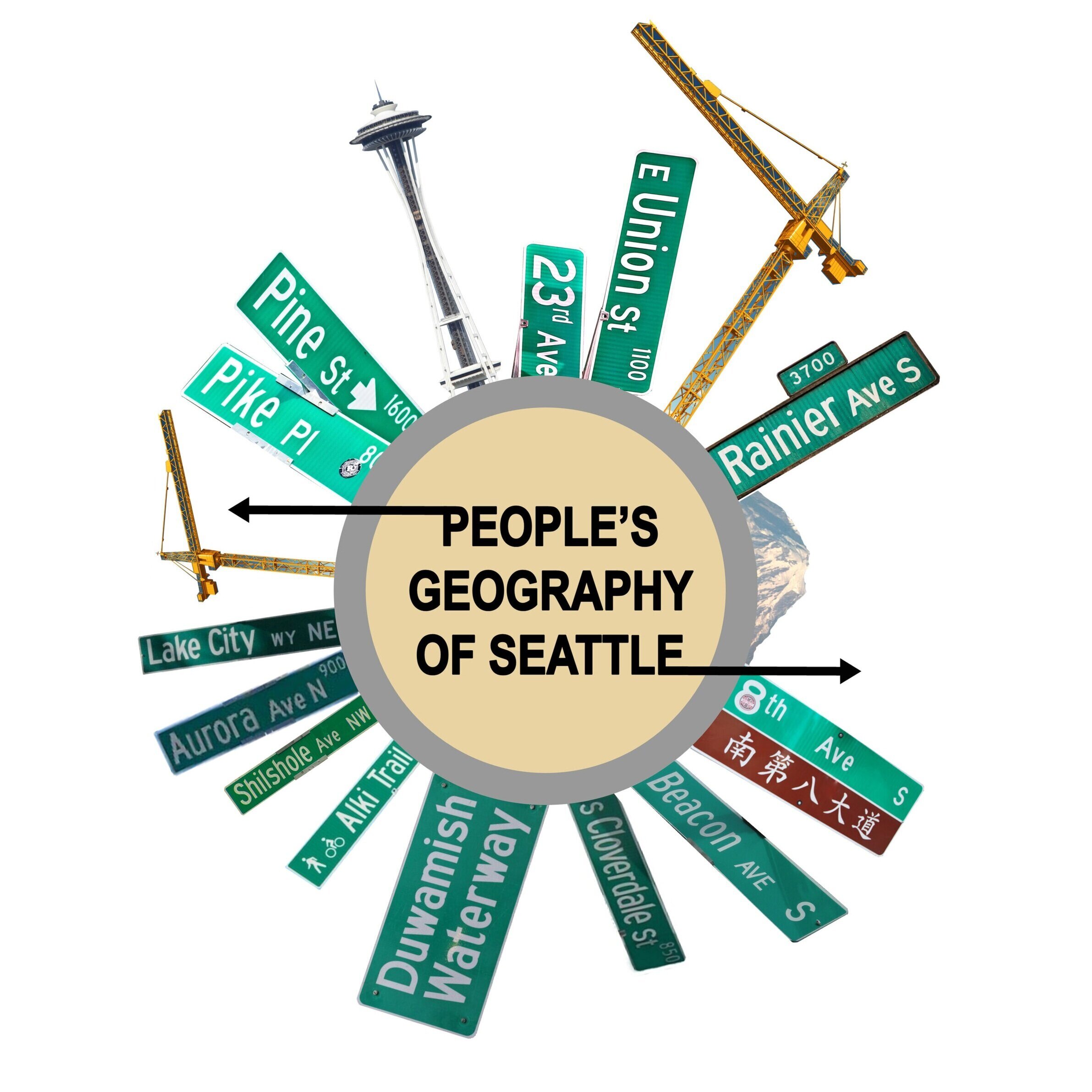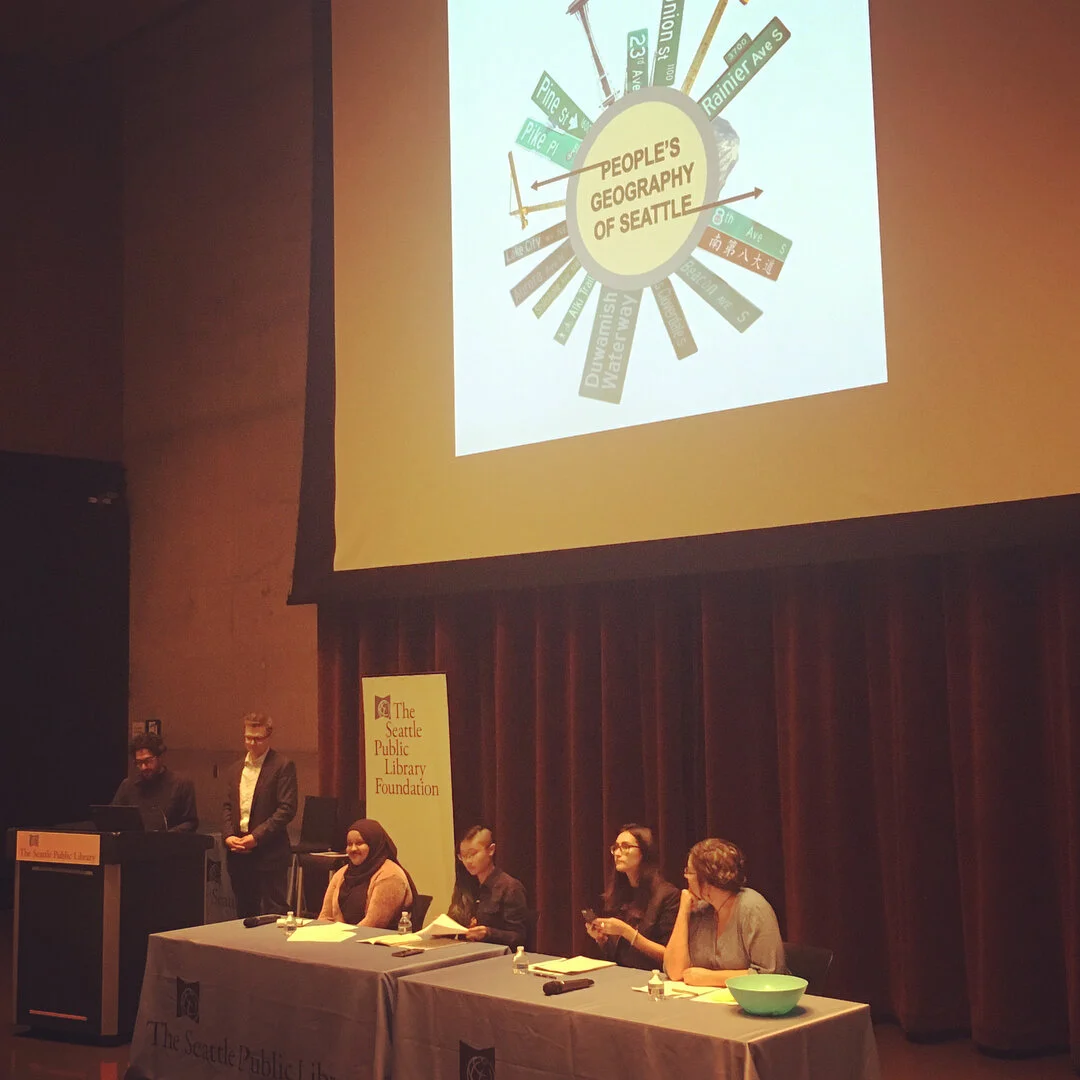[Linking image and below: Unofficial People’s Geography of Seattle logo]
People’s Geography of Seattle
Over the last decade, Seattle has been rapidly transformed by development at an immense rate and scale. At the city’s core, an entire neighborhood has been remade as an urban campus in Amazon’s own image—a process undertaken with remarkable speed, little public input, and tremendous ripple effects across local demographic, cultural, economic, and literal landscapes. This is but one instance of disruptions, displacements, and reconfigurations across a much wider array of urban and natural environments in the region, the likes of which—though now taking place in historically distinctive ways—have occurred on this land and been experienced by people here before. In this sense, changes and dynamics ongoing in Seattle today can be understood in relation to far longer sweeps of settler-colonial history and structural inequity, and far deeper histories of struggle and resilience. In these contexts, The People's Geography of Seattle (PGS) is a flexible umbrella project aiming to facilitate participatory collaborations at intersections among public history, popular inquiry, creative praxis, community activism, and place-based organizing in response to concerns such as those just outlined.
The PGS is less a static thing than a set of questions and overlapping ambitions shared among a loose group of contributors: Amid the struggles and transformations ongoing in the city and region, how might people based within the University of Washington—a public university and ostensibly a public resource committed to the pursuit of equity, justice, and access backed by robust knowledge and research—work with community-based collaborators to facilitate connections, identify emergent common interests and concerns, and build collective infrastructures to research and address structural violence, inequity, gentrification and displacement, environmental injustice, and other intertwined challenges currently facing Seattle and the region? The PGS seeks to facilitate a range of activities that could press this question and further these ends: creating space to bring existing initiatives into conversation and study with one another; creating opportunities for public conversation and exchange so that such initiatives and their concerns might more readily register within ongoing debates about place, urban development, and (in)justice in Seattle; undertaking participatory action research with communities according to their own priorities; curating archival, cartographic, geovisual, and other resources in relation to all of these activities; and more. What possibilities might you imagine?
Below is an overview of some of the activities that PGS collaborators have organized / undertaken to date, toward the aims stated above:
Starting in 2020—amid the COVID-19 pandemic, the uprisings for racial justice, and the deepened urgency of place-based organizing for Black lives and struggles—PGS collaborators began working with community-based collaborators to pursue forms urban spatial analysis toward place-based equity, particularly through forms mapping, storytelling, and counter-narrative. This work included:
Story-mapping for King County Equity Now: In the summer of 2020, faculty collaborators Carrie Freshour and Christian Anderson were joined by a group of talented students—doctoral student Soohyung Hur (geography) and undergraduate students Anthony Tran (geography), Dejai Mitchell (Urban Planning), and Elena Lecoq (Social Work). Together we produced story maps which helped visualize and contextualize the emerging organizing work of an organization called King County Equity Now (KCEN)—an evolving coalition of more than 50 Black-led, community-based organizations fighting to achieve equity (in the sense of both justice and ownership stakes) for Black individuals, families, businesses, and communities in Seattle and the region. KCEN coalesced amid the events of the spring of 2020 with a clear vision for confronting decades of inequity, disruption, and displacement disproportionately affecting historically Black neighborhoods within Central and South Seattle. Central to that vision, KCEN articulated a set of objectives aimed at stopping predatory development and turning underutilized land, facilities, and other resources in these neighborhoods into assets for Black-owned and operated economic, cultural, and community development. In those contexts, the PGS team undertook research and story mapping to contextualize and explain the deeper stories and significance behind the specific sites and pieces of land named in those objectives. This work was further extended by undergraduate student research through an honors seminar in geography—taught by Freshour—extending across all three quarters of the 2020-21 academic year. Combining GIS, spatial analysis, archival, and critical qualitative skills to develop story-maps about specific place-based histories and struggles, this work produced knowledge and visualizations for KCEN’s own community engagement and visioning process as well as for ongoing conversations and organizing around space, place, race, and equity more broadly.
Black Spatial Histories Institute: Continuing to engage many of the themes from the above story mapping work in a more focused and in-depth way, PGS collaborators also spent late 2020 and early 2021 exploring possibilities for collaboration with several co-founders of Wa Na Wari—a center for Black art and belonging, located in Seattle’s historically Black Central District (CD). Known as “the house that fights displacement with art,” Wa Na Wari creates space for Black ownership, possibility, and belonging through art, historic preservation, and connection. It was founded by four collaborators with 80 years of cumulative experience as public artists, oral historians, community organizers, and educators. Together with three of those co-founders (Inye Wokoma, Jill Freidberg, and Rachel Kessler) PGS collaborators (Christian Anderson, Carrie Freshour, and Jin-Kyu Jung) have been feeling out possibilities and seeking resources to pilot a Black Spatial Histories Institute (SBSHI). The idea is that over the course of 2021-22, the SBSHI will field a cohort of 6 community researchers to respond to community-identified priorities and gather stories about people’s ongoing experiences in the contexts of the deep histories and current struggles against inequity, gentrification, and displacement in and extending out from the CD. That work will feature an “institute” model, in which cohort members train and establish a shared vision around questions, aims, and methods before then gathering stories (remotely). At the same time, another aim is to develop community-informed strategies for sharing and activating the stories that have been gathered.
Frankly, the team at Wa Na Wari—along with community participants—are so far doing all of the work to get the SBSHI off of the ground, and they are more than fully capable of pulling off this vision on their own. PGS collaborators are humbled by and trying to figure out how we can bring enough to the table to warrant our getting more involved. If we can, we hope to then learn from and slowly build relationships that may lead to further collaboration with this accomplished and well-respected crew. Stay tuned to learn more about how this turns out!
Over the course of 2018-19, core PGS contributors worked with a group of talented students and faculty from the Interactive Media Design program at the University of Washington Bothell to create unARchived, a pilot for a place-based digital story telling platform including an augmented reality app and a website. We chose to focus on Pioneer Square—Seattle’s first neighborhood, literally layered with the sediments of foundational displacements and cultural-economic and political-ecological forces which continue to shape the city—to demonstrate the possibilities for this platform. We created a short film providing an overview of the idea and the vision for unARchived, also meant to invite potential community collaborators to imagine the kinds of place-based stories they might tell about their own spaces and struggles. We also presented a short conference paper outlining some of the ideas behind unARchived in the context of the broader PGS, for which we received feedback from a national audience of other critically engaged place-based scholars. Sadly for the PGS, the unARchived project lead—Abe Avnisan—has since moved out of state to pursue other opportunities. But the vision and the basic elements of the platform remain. We are currently pursuing new opportunities to continue the work started here with new collaborators.
In the spring of 2018, we hosted Dr. Laura Pulido—professor and head of Ethnic Studies, and professor of geography at the University of Oregon—to discuss two projects: The People’s Guides, a series of radical tour guides which Dr. Pulido helps to edit, and an emerging project called Sangre en la Tierra (Blood in the Soil), a historical atlas of foundational white supremacy in the United States. Both projects aim to transform people’s experience and understanding of place as a site of racial history and struggles for social justice, and both provoked us to imagine what iterations of these kinds of projects might look like if we undertook them in Seattle and the region. Indeed, many of these ideas informed the vision for unARchived outlined above. Further, the notion of “the people” within the PGS name took as its inspiration from these projects and the radical place-based traditions they evoke.
In the winter of 2018, we hosted a public conversation at the downtown branch of the Seattle Public Library. This event—attended by over 150 people—brought together artists, scholars and activists looking at a few dimensions of the changing geographies and histories of the Seattle region. Many of the featured projects combined a critical understanding of culture, politics, and ecology with forms of creative mapping, visual, and/or audio representation. The event highlighted projects engaging questions of change, narrative, rights, justice, health, equity, and more, both in the built environment and within communities. Co-moderated by Amir Sheikh (another central collaborator who has since moved out of state to pursue other opportunities) and myself, the panel included:
Cynthia Brothers, who started Vanishing Seattle in 2016 to document displaced and disappearing institutions, cultures, and communities of Seattle.
Hodan Hassan, a community organizer, writer and actor with a Political Science degree from the University of Washington, now working with the South Seattle based, people of color-led climate justice organization, Got Green.
Jill Freidberg, a documentary filmmaker, oral historian, radio producer, and youth media educator. Jill focused especially on The Shelf Life Community Story Project—an in-depth archive of interviews and oral histories from Seattle’s historically Black Central Neighborhood.
Cheuk-Ning, a 2016 Seeding Change Fellow with the Chinese Progressive Association in San Francisco's Chinatown, organizing with the CID Coalition and Pacific Rim Solidarity Network (Parisol) in Seattle’s Chinatown International District
The event also featured and began with a short excerpt from a film by Central Neighborhood based artist and film-maker Inye Wokoma, which set the tone for the conversation by evoking deep connections between Black identity, history, tradition, community, ownership, land, self-determination, family and collective thriving, all currently being disrupted by ongoing the gentrification and displacement of Black residents from the historically Black neighborhoods of Seattle.
An audio recording of the entire library event is available here (or upon request). A transcript is available here.


